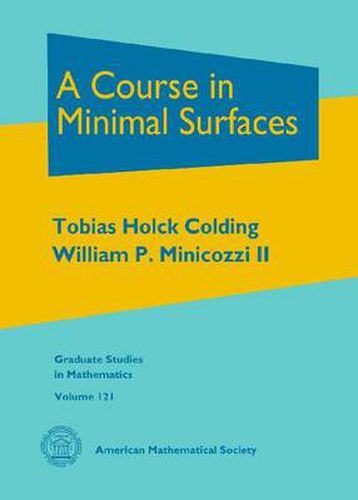Readings Newsletter
Become a Readings Member to make your shopping experience even easier.
Sign in or sign up for free!
You’re not far away from qualifying for FREE standard shipping within Australia
You’ve qualified for FREE standard shipping within Australia
The cart is loading…






Minimal surfaces date back to Euler and Lagrange and the beginning of the calculus of variations. Many of the techniques developed have played key roles in geometry and partial differential equations. Examples include monotonicity and tangent cone analysis originating in the regularity theory for minimal surfaces, estimates for nonlinear equations based on the maximum principle arising in Bernstein’s classical work, and even Lebesgue’s definition of the integral that he developed in his thesis on the Plateau problem for minimal surfaces.
This book starts with the classical theory of minimal surfaces and ends up with current research topics. Of the various ways of approaching minimal surfaces (from complex analysis, PDE, or geometric measure theory), the authors have chosen to focus on the PDE aspects of the theory. The book also contains some of the applications of minimal surfaces to other fields including low dimensional topology, general relativity, and materials science.
The only prerequisites needed for this book are a basic knowledge of Riemannian geometry and some familiarity with the maximum principle.
$9.00 standard shipping within Australia
FREE standard shipping within Australia for orders over $100.00
Express & International shipping calculated at checkout
Minimal surfaces date back to Euler and Lagrange and the beginning of the calculus of variations. Many of the techniques developed have played key roles in geometry and partial differential equations. Examples include monotonicity and tangent cone analysis originating in the regularity theory for minimal surfaces, estimates for nonlinear equations based on the maximum principle arising in Bernstein’s classical work, and even Lebesgue’s definition of the integral that he developed in his thesis on the Plateau problem for minimal surfaces.
This book starts with the classical theory of minimal surfaces and ends up with current research topics. Of the various ways of approaching minimal surfaces (from complex analysis, PDE, or geometric measure theory), the authors have chosen to focus on the PDE aspects of the theory. The book also contains some of the applications of minimal surfaces to other fields including low dimensional topology, general relativity, and materials science.
The only prerequisites needed for this book are a basic knowledge of Riemannian geometry and some familiarity with the maximum principle.